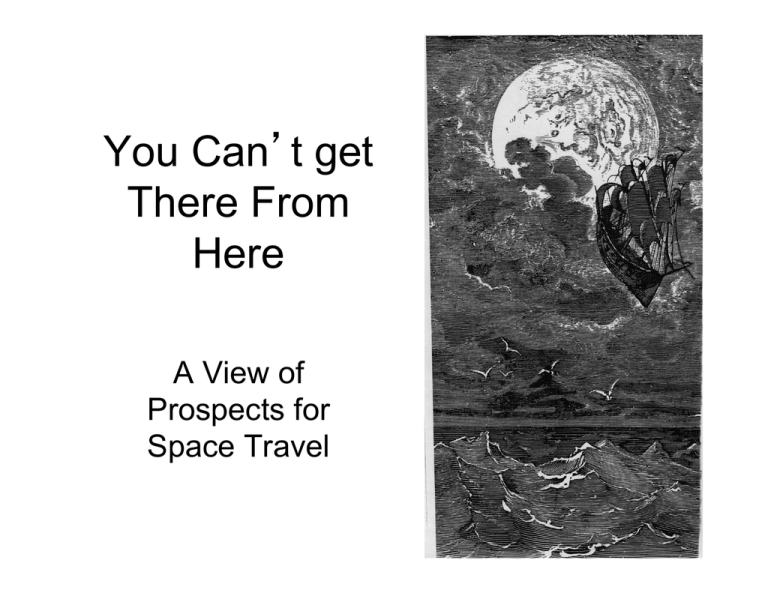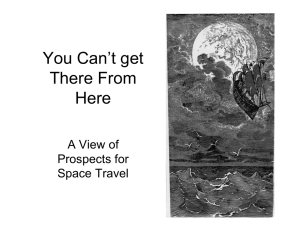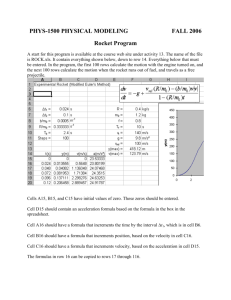You Can’t get There From Here A View of
advertisement

You Can’t get There From Here A View of Prospects for Space Travel The Rocket Equation Rockets work on the principle of Conservation of Momentum Consequences of the Rocket Equation How Much Fuel Do You Need? The Cost to Accelerate Power and Acceleration. I. 1 gravity (g; 980 cm/s2) is a comfortable acceleration a=2P/ms, where a is the acceleration, P is the power, m is the mass, and s is the exhaust speed. A chemical rocket requires P>1.5 kW/kg Burning 2H2 + O2 -> 2H2O liberates 4 kW hr/kg. To accelerate a mass m at 1g requires burning H2+O2 at a rate of 10-3 m gm/sec. The Saturn V burned 3000 tons of kerosene+O2 per second. Power and Acceleration. II. To accelerate at g: • A chemical rocket must generate 1.5kW/kg • A nuclear fusion rocket must generate 440 mW/kg • A matter-antimatter rocket must generate 1.5Gw/kg • Power plants typically generate 0.5-1 Gw of power The Speed Limit c = 3 x 105 km/s Special Relativity to the Rescue? Time Dilation. I. Theory Time Dilation. II. Practice Possible Outs. I. Why carry your fuel? The Bussard Ramjet • Space is not empty: about 0.1 H/cm3 • Hydrogen is an excellent fuel • To sweep up 1 gm of H, with - v = 0.99c - 100% efficiency requires a scoop radius of 40 km. The atoms appear to be coming at you at 0.99c - or with 6 GeV (0.01 erg) rest energies How do you stop them? Possible Outs. II. Why carry your fuel? The Light Sail Works just like a sailboat, by conservation of momentum. • p = E/c (momentum carried by a photon) • a = 2P/mc (acceleration; P=power) • P = LA/4πd2 (L=luminosity; A=sail area) To accelerate a mass of 100 tons at 1 g requires P=150,000 GW, or a sail the size of a star, when you are a 2 light years out (half way between the stars. Possible Outs. III. Why go all the way? Look for a wormhole. The shortest distance in 3 dimensions may not be the shortest in 4 (or more) dimensions! An Einstein-Rosen bridge is a wormhole connecting two different universes. Do wormholes exist? • Solutions of General Relativity permit them. • They are unstable (barring exotic matter with a negative energy density). • They require a “white hole” on the other end, which violates the second law of thermodynamics. Possible Outs. IV. Warping space. • You can exceed c globally; you cannot exceed it locally. • If you can make space contract ahead, and expand behind, your local space can move with an arbitrarily high velocity. Warping space requires: • An awful lot of energy • Exotic particles with negative energy • Negative gravity But you get: • Arbitrarily fast speeds • No time dilation • No acceleration • No causal paradoxes Conclusions • 1g accelerations are convenient for human space travel. • Chemical fuels can provide this acceleration, but the small S means that mi/mf is prohibitive. • Nuclear fusion provides better mass ratios, at the cost of low acceleration. • Matter-antimatter provides the best mass ratios, but requires the most power. • At present, there is no reasonable expectation of travel at 1g accelerations for significant distances. Space is big; space travel is slow.





